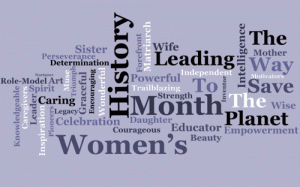Celebrating Women's History — Past & Present

It's about that time again — when women worldwide celebrate Women's History Month and International Women's Day (March 8), whose beginnings to back 150+ years to a single act of protest in 1857, when New York garment workers protested their miserably low wages and the deplorably unsafe conditions in which they worked. Since then, millions of women worldwide have joined together — asking for decent wages and safer working conditions in their factories and work places; asking for the right to vote, the right to hold office, the right to own property and to accrue and manage their own assets. Yet, in Texas, and throughout the U.S., the earnings gap remains, and at the highest education levels, it widens rather than narrows as might be expected, if both possess equal degrees or professional certifications. When we discuss equal pay, pay equity or the gender gap in wages, we sometimes lump different aspects together in one issue. There are at least two: one having to do with equal pay for equal work, the other with pay equity — equal pay for work of equal value. The gap exists either way — women earning different (less) wages for the same or similar work and traditional "women's work" such as nursing or teaching, which is valued less, no matter our lip service to its import and value to humankind's future. Since 1975, March 8th has been celebrated as International Women's Day, as declared by the United Nations. It's a day all over the world designated for celebration honoring the achievements and progress for women around the world. When asked to rate their satisfaction or dissatisfaction — to say how empowered they believed themselves to be — in 6 areas: health and safety, educational opportunities, work and career, opportunity for economic independence, to participate meaningfully in decisions related to family and related to community or society. Five years ago, that index stood at 64 on a scale of 100. One way of interpreting this is to say, 5 years ago, we believed we were, perhaps, 2/3rds of the way "there." Another way to look at it is this: for all their hope and optimism, about 2 out of 3 women wished then only to have enough money to live and pay their bills. I cannot imagine that any change in the last few years is statistically significant. So, I pause to consider women's gains (and losses), to contemplate the journey still ahead of us, to catch my breath before once more letting it go. So as we pause to celebrate Women's History, Past and Present, let us do so with joy and optimism of continued change and the word that means much to most: progress. Author: Phyllis Mayo with contributions from Dr. Shanta Proctor
